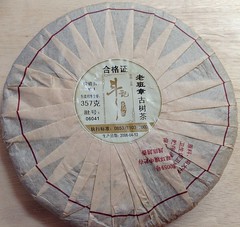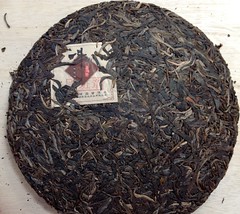That box of LBZ cakes have been untouched for seven years so I tried to call his bluff and threatened to brew it up for him Friday afternoon. But he was all game. So we'll see if anyone in this household has a taste for LBZ. Our friend Stickman also stopped by as he was in the neighborhood and without too much arm twisting, he braved his very first cup of shengpu- a "legendary" LBZ no less. LBZ was tea of choice to make tribute tea for Chairman Mao- a "tea maniac" according to this useful post by Hojotea which also explains how Chen Sheng Tea Factory moved in to control LBZ mao cha prices. Is all the fuss about this LBZ warranted? We were all about to answer for ourselves.
The last time I brewed this cake seven years ago, I got so jacked on a few tablespoons, I had to flush out my body with a gallon of water. The yang in this tea is undeniably strong and deserving of the reputation of possessing the greatest force of cha qi in the world. Is it record breaching levels of theanine(as Nick helpfully informs me) and caffeine or even some other compound the Western world needs to get on. The Banzhang complexity I cannot attest to as I am not able to down enough of it to say. I guess if you want to get jacked legally, this is a good way to go.
The cake is pleasingly furry and it's tea fragrance makes you wish the whole world could smell like this. The brew is still straw colored. Two tiny thimblefuls burn a hole in my stomach immediately and so I know this cake is still going strong. I barely get a chance to register that the brew still has a taste of that Banzhang bitterness- very different from the polite Douji LBZ of the same year. (I may have to compare my autumn Mengku LBZ with the Douji if it was a matter of seasons. ) I could have brewed up in a Yixing pot to soften it up but lately I just like to peep in on the leaves with a glass teapot. Plus used Yixing pots smell so fragrant already, I like to sniff the unadulterated version.
I just keep on watching longingly as my tea partners imbibe cup after cup. They are not men that talk about tea floridly. (Not yet at any rate.) Both were getting suitably buzzed. "Oh yeah. Oh yeah. It's rocket fuel!" They tell me the buzz is different from caffeine, less jittery more productive.
I definitely find advertised burnt leaves to indicate "human handling" in the kill-green process. I'll include the Hai Lang description taken off of YS:
" In the strainer you might notice some slightly burnt leaf edges that separate during brewing (This attests to its hand-process kill-green process). "
The head cook(*) in our house dry-fries greens in the wok all the time, and I have watched plenty of videos of the kill-green process. Personally I think you are frying way too much at one time and not flipping enough if you get burnt leaves. IMMHO. (* This morning, I took a brief break to whisk my hot chocolate bars in almond milk when I noticed someone had changed the "I" on my edit screen to "my husband". While I used to dry fry a lot for many many years, this task has been taken up by my more mindful husband who does not get too many burnt edges except when he controls it for intentionally for extra flavor. He has been teasing me mercilessly all morning on this account so I flipped "my husband" to "head cook". This morning I also had to resort to cheering myself up with a mug of hot chocolate to accompany my bacon and pancake breakfast after a disappointing bout with a pressed pure golden bud dianhong. The beeng smelled amazing but tasted rather plain.)
I also notice various levels of oxidation in the larger leaves. I'm stretching my walnut wondering if this cake is aging or it this is original oxidation from the extra loving fry during the kill-green. It looks too uneven to be aging and with the burnt edges I would do best to assume a less favorable cause.
This here cake was $37 in late 2006- a ridiculously piddly sum by today's levels. But back then - it was considered to be on the high end for Yunnan Sourcing offerings whose been prices were more commonly in the $10-$25 range. I don't regret buying this cake. Apparently my husband likes it and it is the only few tradable things in my collection. But I cannot imagine paying real money for an LBZ now.









